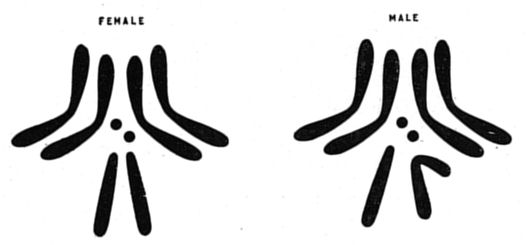Today’s guest post was contributed by Nele Haelterman, an assistant professor in the molecular and human genetics department at Baylor College of Medicine, where she runs a multidisciplinary team science project to understand the neuronal changes that take place in joints as we age, exercise, or develop joint disease. Nele loves combining science communication and advocacy: she runs a blog for early career scientists (ecrLife) and promotes open, reproducible science (reproducibility 4 everyone). You can follow Nele on LinkedIn.
Excitement—almost immediately followed by disappointment.
That’s what Dr. Stuart Newfeld, Professor of Cellular and Molecular Biosciences at Arizona State University, recollects feeling nearly twenty years ago when he identified a predicted gene whose sequence suggested a function in his favorite pathway—only to find out that it was located on the fourth chromosome. This is an all too familiar feeling for Drosophilists, who have mostly avoided studying genes on the fourth due to a lack of available tools that can genetically manipulate genes located on this chromosome. All of that is about to change, however, with the Fourth Chromosome Resource Project (FCRP), a collection of genetic resources that Newfeld and his team report in the February issue of GENETICS.
The fruit fly genome contains four chromosomes: the X and Y sex chromosomes, two large autosomes (chromosomes two and three), and a small fourth autosome that is also called the “dot chromosome” because of its size (see image below). While scientists have studied the function of most genes located on the first three chromosomes, they have only investigated a handful of fourth chromosome genes. This is because the majority of the dot chromosome consists of densely packed heterochromatin and there is no meiotic recombination. Together these features make genes on the fourth chromosome less amenable to many of the genetic technologies that scientists typically use to study gene function in flies.

After years of frustration at the slow pace of work on the interesting fourth chromosome gene, Newfeld decided to focus instead on creating genetic tools to overcome the limitations of the fourth and pave the way for the fly community to start tackling all fourth genes. Newfeld and colleagues in Indiana and Minnesota launched the FCRP with the goals of developing “off-the-shelf” fly strains to study genes on the fourth chromosome and making these lines available to the entire community. The collection contains several types of genetic tools to study a gene’s expression pattern and function, as well as stocks to express the wildtype fly gene or its human counterpart (UAS.fly cDNA and UAS.human cDNA). The team created protein and gene traps by combining the MiMIC, CRIMIC, and Doubleheader technologies developed by the lab of Hugo Bellen as part of the Gene Disruption Project.
This resource effectively enables scientists to plug and play with FCRP lines to understand when, where, and how a fourth chromosome gene functions. You can 1) order mutants for your gene of interest, 2) analyze when and where it is expressed, 3) rescue observed phenotypes with the fly cDNA, and 4) determine which human homolog(s) have conserved this aspect of the fly gene’s function(s). In addition, researchers studying human disease genes can use FCRP mutant lines to introduce potential disease-causing variants identified in patients with a hereditary disease to assess how they impact gene function, an approach pioneered by the Bellen lab.
The FCRP collection also contains a set of tools that enable clonal analysis of fourth chromosome genes, which wasn’t previously possible due to the lack of recombination on the fourth chromosome. To enable mitotic recombination on the fourth, Newfeld and his team created an FRT site near the fourth chromosome’s centromere and next added a repressor and a repressible marker to it. They also leveraged recently discovered fly mutants that promote recombination on the fourth to enable meiotic recombination (see Goldsmith et al., 2022). Finally, they are in the process of creating a set of CRISPR mutations in fourth chromosome genes on FRT-containing chromosomes. Together, these lines will enable scientists to generate homozygous mutant clones in an otherwise heterozygous mutant background (i.e., mosaic analysis) to study gene function(s) in a single cell or a single tissue. A paper describing this set of stocks in detail is in preparation.
“It’s always been hard to investigate the functions of fourth chromosome genes,” said Cale Whitworth, codirector of the Bloomington Drosophila Stock Center. “We’re glad the NIH Office of Resource Infrastructure Programs recognized the importance of developing these stocks, and we’re really excited about making them available to fly researchers.”
Newfeld does have a word of caution for those venturing into studying the fourth: don’t forget about position effect variegation. “When we say the fourth is open for business, we don’t mean you should go there blindly,” Newfeld says. “Even with all of our tools, you should still be aware that gene and transgene silencing via heterochromatin expansion occurs at a higher frequency on the fourth compared to the other chromosomes. So it’s really important to always do your control crosses.
“For Drosophilists looking for their next project, Newfeld recommends exploring the paper’s Supplemental Table 4, which lists all ~450 stocks that were generated for the 79 protein-coding fourth chromosome genes. These lines can also be found by entering “Fourth Chromosome Resource Project” on the Bloomington or Kyoto stock center websites. This resource will continue to grow as the work expands, with 50 additional stocks submitted to the stock centers since the paper was accepted.
References
Fourth Chromosome Resource Project: a comprehensive resource for genetic analysis in Drosophila that includes humanized stocks
Michael J Stinchfield, Brandon P Weasner, Bonnie M Weasner, David Zhitomersky, Justin P Kumar, Michael B O’Connor, Stuart J Newfeld
GENETICS. February 2024. 226(2).
DOI: 10.1093/genetics/iyad201




